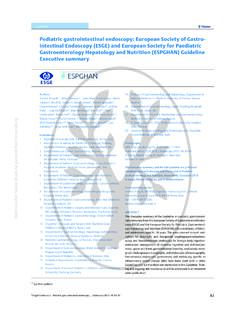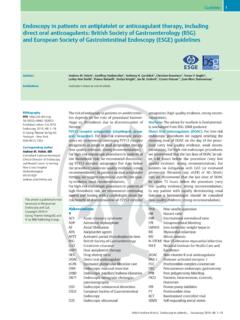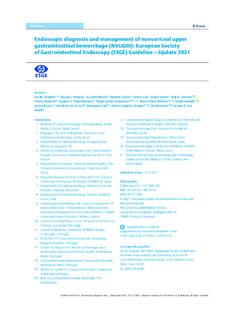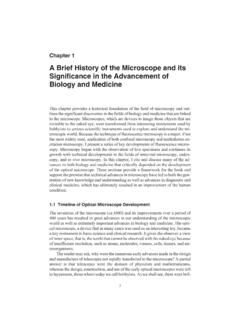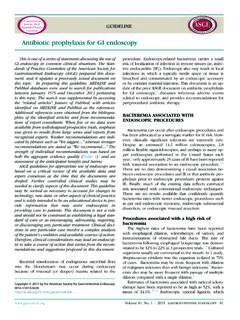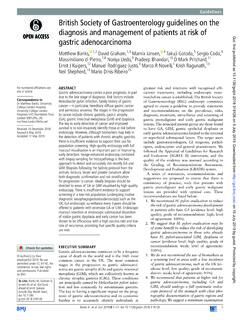Transcription of Colorectal polypectomy and endoscopic mucosal ... - ESGE
1 Colorectal polypectomy and endoscopic mucosal resection (EMR):European Society of Gastrointestinal Endoscopy (ESGE) ClinicalGuidelineAuthorsMonika Ferlitsch1,2,AlanMoss3,4,CesareHassan5,P radeepBhandari6, Jean-Marc Dumonceau7,GregoriosPaspatis8,RodrigoJov er9,CordLangner10,MaximeBronzwaer11, Kumanan Nalankilli3,4,Paul Fockens11,RawiHazzan12, ,MichaelGschwantler2, Elisabeth Waldmann1,2, Philip Jeschek1,2, DanielaPenz1,2,DenisHeresbach13, Leon Moons14, Arnaud Lemmers15,Konstantina Paraskeva16, Juergen Pohl17, Thierry Ponchon18,Jaroslaw Regula19, Alessandro Repici20, Matthew D. Rutter21,Nicholas G. Burgess22,23, Michael J. Bourke22,23 Institutions1 Department of Internal Medicine III, Division ofGastroenterology and Hepatology, Medical University of Vienna,Austria2 Quality Assurance Working Group of the Austrian Society ofGastroenterology and Hepatology3 Department of endoscopic Services, Western Health,Melbourne, Australia4 Department of Medicine, Melbourne Medical School WesternPrecinct, The University of Melbourne, St.
2 Albans, Victoria,Australia5 Digestive Endoscopy Unit, Nuovo Regina Margherita Hospital,Rome, Italy6 Solent Centre for Digestive Diseases, Queen Alexandra Hospital,Portsmouth, UK7 Gedyt Endoscopy Center, Buenos Aires, Argentina8 Department of Gastroenterology, Benizelion General Hospital,Heraklion, Crete, Greece9 Unidad de Gastroenterolog a, Servicio de Medicina Digestiva,Instituto de Investigaci n Sanitaria ISABIAL, Hospital GeneralUniversitario de Alicante, Alicante, Spain10 Department of Pathology, Medical University of Graz, Graz,Austria11 Department of Gastroenterology, Academic Medical Center,University of Amsterdam, Amsterdam, The Netherlands12 Institute of Gastroenterology and Hepatology, Ha EmekMedical Center, Afula, Israel and Rappaport Family Faculty ofMedicine Technion-Israel Institute of Technology, Haifa, Israel13 Department of Digestive Endoscopy, University Hospital, CHUFort de France, France14 Department of Gastroenterology and Hepatology, UniversityMedical Center Utrecht, Utrecht, Netherlands15 Department of Gastroenterology, Hepatopancreatology andDigestive Oncology, Erasme Hospital, Universit Libre deBruxelles (ULB)
3 , Brussels, Belgium16 Konstantopoulio General Hospital, Athens, Greece17 Department of Gastroenterology, Asklepios Klinik Altona,Hamburg, Germany18 Department of Endoscopy and Gastroenterology, EdouardHerriot Hospital, Lyon, France19 Department of Gastroenterology, Maria Sklodowska-CurieMemorial CancerCenter and Medical Centre for Postgraduate Education,Warsaw, Poland20 Humanitas Research Hospital, Humanitas University, Rozzano,Milan, Italy21 School of Medicine, Pharmacy and Health, Durham University,Durham, UK22 Department of Gastroenterology and Hepatology, WestmeadHospital, Sydney, Australia23 University of Sydney, Sydney, | Endoscopy2017; 49: 270 297 Georg Thieme Verlag KG Stuttgart New YorkISSN 0013-726 XCorresponding authorMonika Ferlitsch, MD, Division of Gastroenterology and Hepatology,Department of Internal Medicine III, Medical University of Vienna,Waehringer Guertel 18 20, A-1090 Vienna, AustriaFax: RECOMMENDATIONS1 ESGE recommends cold snare polypectomy (CSP) as the preferredtechnique for removal of diminutive polyps (size 5mm).
4 Thistech-nique has high rates of complete resection, adequate tissue sam-pling for histology, and low complication rates. (High quality evi-dence, strong recommendation.)2 ESGE suggests CSP for sessile polyps 6 9mm in size because ofits superior safety profile, although evidence comparing efficacywith hot snare polypectomy (HSP) is lacking. (Moderate quality evi-dence, weak recommendation.)3 ESGE suggests HSP (with or without submucosal injection) for re-moval of sessile polyps 10 19mm in size. In most cases deep ther-mal injury is a potential risk and thus submucosal injection prior toHSP should be considered. (Low quality evidence, strong recom-mendation.)4 ESGE recommends HSP for pedunculated polyps. To preventbleeding in pedunculated Colorectal polyps with head 20mm or astalk 10mm in diameter, ESGE recommends pretreatment of thestalk with injection of dilute adrenaline and/or mechanical hemo-stasis.
5 (Moderate quality evidence, strong recommendation.)Appendix e1, e2 Online content viewable at: Monika et al. Colorectal polypectomy and .. Endoscopy 2017; 49 This Guideline is an official statement of the European So-ciety of Gastrointestinal Endoscopy (ESGE). The Grading ofRecommendations Assessment, Development, and Evaluati-on (GRADE) system was adopted to define the strength ofrecommendations and the quality of endoscopic removal of Colorectal polyps reduces the inci-dence and mortality of Colorectal cancer (CRC) and is consid-ered an essential skill for all endoscopists who perform colonos- copy [1 3]. Various polypectomy techniques and devices areavailable, their use often varying based on local preferencesand availability [4 6]. This evidence-based Guideline was com-missioned by the European Society of Gastrointestinal Endos- copy (ESGE).
6 It addresses all major issues concerning the prac-tical use of polypectomy and endoscopic mucosal resection(EMR), to inform and underpin this fundamental technique incolonoscopy and in CRC Guideline does not address management of anticoagu-lants and other medications in the periprocedural setting, norpost- polypectomy surveillance or quality measurements, asthese are addressed in separate Guidelines [7 9].MethodsThe European Society of Gastrointestinal Endoscopy (ESGE)commissioned this Guideline and appointed a Guideline leader( ) who invited the listed authors to participate in the pro-ject development. The key questions were prepared by the co-ordinating team ( , , , ) and then approvedby the other members. The coordinating team formed taskforce subgroups, each with its own leader, and divided thekey topics (polyp classification, polypectomy for polyps sized<20mm, EMR for polyps 20mm, technical considerations,adverse events, histopathology) among these task forces (seeAppendix 1,available online in Supplementary material).
7 Each task force performed a systematic literature search toprepare evidence-based and well-balanced statements on theirassigned key questions. Searches were performed in were first selected by title; their relevance was thenconfirmed by review of the corresponding manuscripts, and ar-ticles with content that was considered irrelevant were exclud-ed. Evidence tables were generated for each key question, sum-marizing the evidence of the available studies (seeAppendix 2,available online in Supplementary material). For important out-comes, articles were individually assessed by the level of evi-dence and strength of recommendation according to the Grad-ing of Recommendations Assessment, Development, and Eval-uation (GRADE) system [10,11].ABBREVIATIONSASGEA merican Society for Gastrointestinal Endos-copyCBFcold biopsy forcepsCIconfidence intervalCRCcolorectal cancerCSPcold snare polypectomyEMRendoscopic mucosal resectionESDendoscopic submucosal dissectionESGEE uropean Society of Gastrointestinal EndoscopyFICE flexible spectral imaging color enhancement(also Fuji Intelligent Chromo Endoscopy)GRADEG rading of Recommendations Assessment,Development and EvaluationHBFhot biopsy forcepsHD-WLEhigh definition white light endoscopyHSPhot snare polypectomyIPBintraprocedural bleedingI-SCANi-SCAN digital contrast (Pentax.)
8 Image proces-sing providing digital image-enhanced endos- copy [IEE])LSLlaterally spreading lesionLSTlaterally spreading tumorMPmuscularis propriaNBInarrow-band imagingNICENBI International Colorectal EndoscopicClassificationNPVnegative predictive valuePECprophylactic endoscopic coagulationPPBpost polypectomy bleedingPPVpositive predictive valueRCTrandomized controlled trialRRrelative riskSMIsubmucosal invasionSMSA size, morphology, site, and accessSTSC snare-tip soft coagulationTEMS transanal endoscopic microsurgeryWHOW orld Health OrganizationWLEwhite light endoscopy5 ESGE recommends that the goals of endoscopic mucosal resec-tion (EMR) are to achieve a completely snare-resected lesion in thesafest minimum number of pieces, with adequate margins andwithout need for adjunctive ablative techniques.
9 (Low quality evi-dence; strong recommendation.)6 ESGE recommends careful lesion assessment prior to EMR toidentify features suggestive of poor outcome. Features associatedwith incomplete resection or recurrence include lesion size> 40 mm, ileocecal valve location, prior failed attempts at resection,and size, morphology, site, and access (SMSA) level 4. (Moderatequality evidence; strong recommendation.)7 For intraprocedural bleeding, ESGE recommends endoscopic co-agulation (snare-tip soft coagulation or coagulating forceps) or me-chanical therapy, with or without the combined use of dilute adre-naline injection. (Low quality evidence, strong recommendation.)An algorithm of polypectomy recommendations according to shapeandsizeofpolypsisgiven( ).Ferlitsch Monika et al. Colorectal polypectomy and.
10 Endoscopy 2017; 49 Each task force proposed statements on their assigned keyquestions which were discussed and voted on during a guide-line meeting in Barcelona in October July 2016, a draftprepared by the leaders and coordinating team was sent to allgroup members. The manuscript was also reviewed by twomembers of the ESGE Governing Board and sent for furthercomments to the National Societies and Individual agreement on a final version, the manuscript was submit-ted to the journalEndoscopyfor publication. All authors agreedon the final revised Guideline was issued in 2017 and will be considered forreview and update in 2022 or sooner if new and relevant evi-dence becomes available. Any updates to the Guideline in theinterim will be noted on the ESGE website: , classification, removal,and retrieval of polypsSuperficial Colorectal NeoplasiaSessile or FlatNon-invasive lesionIntermediateSize 10 19 mmHot Snare polypectomy (HSP)4 Submucosal injection prior to HSP should be considered to reduce the risk of deep thermal injuryLargeSize 20 mmEn bloc endoscopic mucosal resection (EMR) to achieve R0 resection5 Piecemeal EMR if en bloc not feasible or not safeIf lesion is sized >40 mm or complex6 refer to expert centerSuspected superficial submucosal invasion7 Colonic tattoo 3 cm distal to the lesion Refer to expert center for consideration of en bloc EMR or endoscopic submucosal dissection (ESD)
